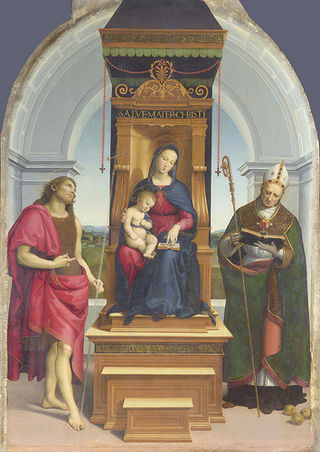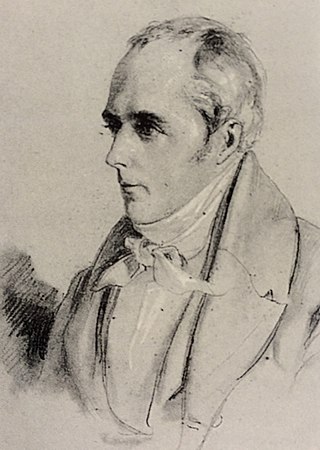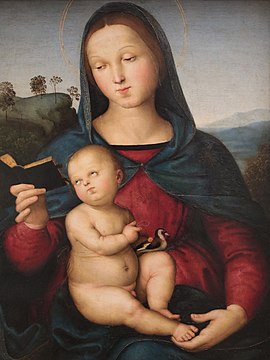
Pinturicchio, or Pintoricchio, also known as Benetto di Biagio or Sordicchio, was an Italian painter during the Renaissance. He acquired his nickname because of his small stature and he used it to sign some of his artworks that were created during the fifteenth and sixteenth centuries.

Carlo Crivelli was an Italian Renaissance painter of conservative Late Gothic decorative sensibility, who spent his early years in the Veneto, where he absorbed influences from the Vivarini, Squarcione, and Mantegna. He left the Veneto by 1458 and spent most of the remainder of his career in the March of Ancona, where he developed a distinctive personal style that contrasts with that of his Venetian contemporary Giovanni Bellini.

Alessandro Bonvicino, more commonly known as Moretto, or in Italian Il Moretto da Brescia, was an Italian Renaissance painter from Brescia, where he also mostly worked. His dated works span the period from 1524 to 1554, but he was already described as a master in 1516. He was mainly a painter of altarpieces that tend towards sedateness, mostly for churches in and around Brescia, but also in Bergamo, Milan, Verona, and Asola; many remain in the churches they were painted for. The majority of these are on canvas, but a considerable number, including some large pieces, are created on wood panels. There are only a few surviving drawings from the artist.

Madonna and Child was painted by one of the most influential artists of the late 13th and early 14th century, Duccio di Buoninsegna. This iconic image of the Madonna and Child, seen throughout the history of western art, holds significant value in terms of stylistic innovations of religious subject matter that would continue to evolve for centuries.

The Gemäldegalerie is an art museum in Berlin, Germany, and the museum where the main selection of paintings belonging to the Berlin State Museums is displayed. It was first opened in 1830, and the current building was completed in 1998. It is located in the Kulturforum museum district west of Potsdamer Platz.

The Madonna of Loreto is an oil on panel painting by the Italian High Renaissance painter Raphael, executed c. 1511. It is housed in the Musée Condé of Chantilly, France.

The Alba Madonna is a tondo (circular) oil on wood transferred to canvas painting by the Italian High Renaissance artist Raphael, created c. 1511, depicting Mary, Jesus, and John the Baptist in a typical Italian countryside.

The Garvagh Madonna is an oil painting by the Italian Renaissance artist Raphael, dating to c. 1509–1510. It depicts the Virgin, the Christ Child and the infant John the Baptist, and is one of many paintings by Raphael with this trio. It is from early in the artist's third, or Roman period, in which distinctive changes are seen from his Umbrian or Florentine period in style and use of colour, with the introduction of more natural subjects and settings.

The Ansidei Madonna is a 1505–1507 painting by the Italian High Renaissance artist Raphael, painted during his Florentine period. It shows the Blessed Virgin Mary sitting on a wooden throne, with the child Christ on her lap. On her right John the Baptist stands, on her left Saint Nicholas is reading.

The Madonna with Child, St. John and a Child Saint is an oil on wood painting by the Italian Renaissance artist Raphael, who executed it around 1504–1505. It is also known as Madonna Terranuova as it belonged to the Italian Dukes of Terranuova, from whom it went to Berlin's Staatliche Museen, where it has been since 1854. It is currently on display in the Gemäldegalerie, Berlin.

The Madonna del Prato, formally Madonna with the Christ Child and Saint John the Baptist, is an oil on board painting by Raphael, created in 1506, now held in the Kunsthistorisches Museum in Vienna. It is also known as the Madonna del Belvedere after its long residence in the imperial collection in the Vienna Belvedere.

The Sistine Madonna, also called the Madonna di San Sisto, is a oil painting by the Italian artist Raphael. The painting was commissioned in 1512 by Pope Julius II for the church of San Sisto, Piacenza, and probably executed c. 1513–1514. The canvas was one of the last Madonnas painted by Raphael. Giorgio Vasari called it "a truly rare and extraordinary work".

Portrait of Pope Julius II is an oil painting of 1511–1512 by the Italian High Renaissance painter Raphael. The portrait of Pope Julius II was unusual for its time and would carry a long influence on papal portraiture. From early in its life, it was specially hung at the pillars of the church of Santa Maria del Popolo, on the main route from the north into Rome, on feast and high holy days. Giorgio Vasari, writing long after Julius' death, said that "it was so lifelike and true it frightened everyone who saw it, as if it were the living man himself".

Madonna with Child with Young John the Baptist is a painting by the German Renaissance painter Lucas Cranach the Elder, dating from 1514. It is housed in the Uffizi Gallery of Florence.

Edward Solly was an English merchant living in Berlin, who amassed an unprecedented collection of Italian Trecento and Quattrocento paintings and outstanding examples of Early Netherlandish painting, at a time when those schools were still largely unappreciated. In 1821, following negotiations by his associate Benjamin Wegner, Solly sold his collection of about 3000 works to the Prussian king; 677 of them formed a core of the Gemäldegalerie, Berlin. Solly acquired a second collection during his years in London after 1821. Solly is also credited for having undertaken a perilous journey to deliver the first news of Napoleon's defeat at the Battle of Leipzig to the English.

The Lamentation of Christ is an oil-on-panel painting of the common subject of the Lamentation of Christ by the Netherlandish artist Rogier van der Weyden, dating from around 1460–1463 and now in the Uffizi Gallery, Florence, Italy.

The Santa Maria dei Fossi Altarpiece is a 1496-1498 painting by Pinturicchio, now in the Galleria nazionale dell'Umbria in Perugia. Unusually for an altarpiece, it is painted on canvas stretched over wooden panels.

The Benedetto Portinari Triptych is a group of three 1487 oil on panel paintings by Hans Memling. It is named after its commissioner, who is probably the subject of its right-hand panel, now in the Uffizi in Florence. The left panel of Saint Benedict and the central panel of the Madonna and Child are both now in the Gemäldegalerie, Berlin. All three panels are set within a single loggia, with a unified landscape background across all three, which proved a major influence on Umbrian painters, Perugino and Leonardo da Vinci.

The 'Diotallevi Madonna is an oil on panel painting by Raphael, created c. 1504. It is held in the Bode Museum, in Berlin, where it entered in 1841-1842 from Marquess Diotallevi's collection in Rimini. Previously attributed to Raphael's teacher Perugino, almost all art historians now attribute it to Raphael, with the exception of Adolfo Venturi who attributes it and parts of Perugino's Madonna della Consolazione to an anonymous, "Master of the Diotallevi Madonna".

The Bridgewater Madonna is a religious painting by Raphael, dated 1507. Originally on oil and wood, but later transferred to canvas, it measures 81 by 55 cm. The picture is part of the permanent collection of the Scottish National Gallery in Edinburgh, on loan from the Duke of Sutherland Collection.




















